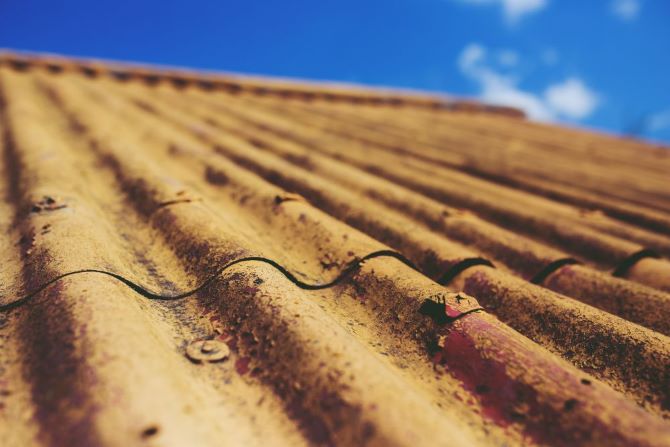Asbestos consists of microscopic fibres that can pose a great danger to your health. It is therefore very important to recognise asbestos in time. That way, if necessary, the asbestos can be removed by an asbestos removal company. On this page you will find all the information around recognising asbestos and the costs associated with asbestos removal.
Cognising asbestos starts with understanding what asbestos is
The term ‘asbestos’ is a collective term for six different minerals found in nature. These minerals consist of fibres. In the past, asbestos was regularly incorporated into all kinds of different building materials. Think, for instance, of corrugated sheets, cement, glue or plastic. They did this because the material was known to be strong, cheap and fire-resistant.
Asbestos poses a health hazard the moment the fibres are released and inhaled. This happens when the asbestos-containing material is corroded in some way (for example, by sawing or drilling into it, but also deterioration due to weather). When these fibres are inhaled, it affects the lungs, possibly resulting in cancer.
Find the best specialist for your project and get free quotes.
Start
Recognising materials with bonded asbestos
Asbestos is not always that dangerous. As mentioned above, asbestos is harmless as long as no fibres are released. With ductile asbestos, there is little chance of fibres being released because the asbestos fibres are trapped in hard material. So this form of asbestos is relatively harmless. For example, tapping on bonded asbestos with a screwdriver sounds like tapping on a blackboard. Adherent asbestos was incorporated into materials such as plastic, glue and cement before 1994.
Cognising materials with loose asbestos
In contrast to adhesive asbestos, loose asbestos is very dangerous. This is because this form of asbestos is a lot softer, is not stuck in other material, and therefore crumbles quickly, releasing fibres more easily. Loose-bound asbestos was regularly used in construction until the 1980s.

How to recognise asbestos?
The asbestos commonly used in the Netherlands is white, blue or brown. Asbestos fibres are microscopic and can therefore not be seen with the naked eye. Fortunately, what you can recognise are the materials in which the asbestos fibres have been incorporated.
Since 1993, the use of asbestos has been banned, but asbestos can still be found in products, materials and buildings from before that time. In short, a first step in recognising asbestos is to look at years of products or materials in your home.
Because asbestos was used in a wide variety of materials and products in the past, it can be difficult to recognise the minerals. However, there are some general properties that all asbestos-containing materials share:
- Asbestos has great insulating properties, both with regard to sound, heat and electricity. Asbestos was therefore previously widely used as an insulating material, for example around hot pipes, in ceilings and roofs.
- Asbestos not only acts as an insulator, but also resists very high temperatures and temperature fluctuations. Asbestos was therefore widely used for stove plates, which in turn were processed in fireplaces and central heating systems.
- Asbestos is very durable and has a high resistance to abrasion. This is also reflected in the origin of the name the minerals. The name ‘asbestos’ comes from the Greek ‘asbestosos’, which means indestructible.
Cognising asbestos in corrugated sheets
While in most materials it is better to leave the task of recognising asbestos to experienced asbestos inventorers, in the case of corrugated sheets it is easy to check.
- Corrugated sheets do not contain asbestos with the letters: NT, AF, AFM, NA, AP or AV
- Corrugated sheets do contain asbestos with the letters: AT, NF, CAF
Where can asbestos be found in and around your house?
| Asbestos outside of house | Type of asbestos |
|---|---|
| Chimney | – Asbestos cement in pipe and cap |
| Roof, dormer or skylight | – Asbestos cement siding, cavity and frame cladding – Asbestos-containing roof sheathing – Asbestos-containing bituminous roofing – Asbestos-containing roof slate – Asbestos-containing sealant between frame and wall – Asbestos-containing coating on steel sheet piling – Sealant masonry, joints, rebates Asbestos-containing sealant (filler) between window frame and wall and in joint – Asbestos-containing adhesives – Asbestos-containing textured paint – Asbestos-containing coating on steel sheet piling – Asbestos fibres as reinforcement in plastics – Sealant masonry, joints, rebates, window frames |
| Shed roof | – Asbestos cement flat panels – Asbestos cement corrugated sheet – Asbestos bituminous roofing – Asbestos coating on steel sheet piling |
| Balcony screen/privacy screens between balcony | – Asbestos cement flat panel – Asbestos cement flat panel, Floor tarpaulin with underlayment made of asbestos-containing paper – Underlayment tiles made of asbestos-containing cardboard |
| Window sill and trim under window frame | – Window sill made of asbestos-containing artificial marble – Trim made of asbestos-containing cement fibreboard or cardboard – Framing behind radiator |
| Kettle, boilers, geysers and other installations | – Asbestos-containing board under CV, plaster or cement – Gaskets, sealing cord – Drainage pipe (sewer, ventilation) made of asbestos cement – Insulation around drain pipe – asbestos-containing plaster cement, fibreboard or cardboard |
| Meter cupboard | – Cladding meter cupboard – Cladding door and skylight with asbestos-containing cardboard, fibreboard or cement – Cover plate crawlspace hatch made of asbestos cement |
| Between wall, suspended ceiling, attic skimming | – System walls with asbestos-containing cement – Cladding and cladding with asbestos-containing cement fibreboard or cardboard |
| Flushing toilet and sewerage | – Cover plate asbestos cement on cistern – Sewerage, down pipe made of asbestos cement – Ventilation duct made of asbestos cement |
| Drainage pipe | – Drainage duct made of asbestos cement – Cladding around roof penetration asbestos cement, cardboard or fibreboard. |

Asbestos inventory: what does it cost?
Do you think you recognise asbestos in or around your home? For the health of you, your housemates and local residents, it is wise to have it checked by a certified asbestos removal company. They can tell with certainty whether asbestos is present and you need to remove it.
There are two investigations: an inventory of visible material and a full inventory that also involves breaking things away. See below what the average asbestos inventory costs are for each type of inventory:
| Type of asbestos inventory | Average cost |
|---|---|
| Inventory of visible material (formerly type A) |
£ 300 – £500 |
| Full inventory (former type B) |
From £450 |
Find the best specialist for your project and get free quotes.
Start